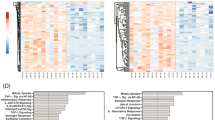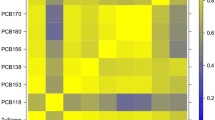Abstract
Arsenic exposure by groundwater contamination is a menace which threatens more than 26 million individuals of West Bengal. Interestingly, with similar levels of arsenic exposure, only 15–20% of the population show arsenic-induced skin lesions, the hallmarks of chronic arsenic toxicity, but the rest do not. In this study, our aim was to identify whether microRNAs (miRNA) have any role to play in causing such arsenic susceptibility. Global plasma miRNA profiling was done in 12 arsenic-exposed individuals with skin lesions and 12 exposed individuals without skin lesions. Two hundred two miRNAs were found to be differentially regulated between the two study groups. Results were validated by quantitative real-time PCR in 30 exposed subjects from each of the groups, which showed that among others miR-21, miR-23a, miR-27a, miR-122, miR-124, miR-126, miR-619, and miR-3613 were significantly upregulated and miR-1282 and miR-4530 were downregulated in the skin lesion group compared with the no skin lesion group. Bioinformatic analyses predicted that these altered miRNAs have targets in 7 different biochemical pathways, including glycerophospholipid metabolism, colorectal cancer, glycosphingolipid biosynthesis, T cell receptor signaling, and neurotrophin signaling pathways; glycerophospholipid metabolism pathway being the most enriched pathway. Association study show that these microRNAs contribute significantly to the increased prevalence of other non-dermatological health effects like conjunctival irritations of the eyes and respiratory distress in the study subjects. To our knowledge, this is the first study of its kind involving miRNA expressions contributing to arsenic susceptibility in the exposed population of West Bengal.



Similar content being viewed by others
References
Banerjee N, Banerjee S, Sen R, Bandyopadhyay A, Sarma N, Majumder P, Das JK, Chatterjee M, Kabir SN, Giri AK (2009) Chronic arsenic exposure impairs macrophage functions in the exposed individuals. J Clin Immunol 29:582–594. https://doi.org/10.1007/s10875-009-9304-x
Banerjee N, Nandy S, Kearns JK, Bandyopadhyay AK, Das JK, Majumder P, Basu S, Banerjee S, Sau TJ, States JC, Giri AK (2011) Polymorphisms in the TNF-α and IL10 gene promoters and risk of arsenic-induced skin lesions and other nondermatological health effects. Toxicol Sci 121:132–139. https://doi.org/10.1093/toxsci/kfr046
Banerjee N, Bandyopadhyay AK, Dutta S, Das JK, Roy Chowdhury T, Bandyopadhyay A, Giri AK (2017) Increased microRNA 21 expression contributes to arsenic induced skin lesions, skin cancers and respiratory distress in chronically exposed individuals. Toxicology 378:10–16. https://doi.org/10.1016/j.tox.2017.01.006
Biswas R, Ghosh P, Banerjee N, Das JK, Sau TJ, Banerjee A, Roy S, Ganguly S, Chatterjee M, Mukherjee A, Giri AK (2008) Analysis of T-cell proliferation and cytokine secretion in the individuals exposed to arsenic. Hum Exp Toxicol 27:381–386. https://doi.org/10.1177/0960327108094607
Calin GA, Croce CM (2006) MicroRNA signatures in human cancers. Nat Rev Cancer 6:857–866
Cermelli S, Ruggieri A, Marrero JA, Ioannou GN, Beretta L (2011) Circulating microRNAs in patients with chronic hepatitis C and non-alcoholic fatty liver disease. PLoS One 6:e23937. https://doi.org/10.1371/journal.pone.0023937
Chakraborti D, Das B, Rahman MM, Chowdhury UK, Biswas B, Goswami AB, Nayak B, Pal A, Sengupta MK, Ahamed S, Hossain A, Basu G, Roychowdhury T, Das D (2009) Status of groundwater arsenic contamination in the state of West Bengal, India: a 20-year study report. Mol Nutr Food Res 3:542–551. https://doi.org/10.1002/mnfr.200700517
Colussi D, Brandi G, Bazzoli F, Ricciardiello L (2013) Molecular pathways involved in colorectal cancer: implications for disease behavior and prevention. Int J Mol Sci 14:16365–16385. https://doi.org/10.3390/ijms140816365
Das N, Paul S, Chatterjee D, Banerjee N, Majumder NS, Sarma N, Sau TJ, Basu S, Banerjee S, Majumder P, Bandyopadhyay AK, States JC, Giri AK (2012) Arsenic exposure through drinking water increases the risk of liver and cardiovascular diseases in the population of West Bengal, India. BMC Public Health 12:639–647. https://doi.org/10.1186/1471-2458-12-639
Guha Mazumder DN (2008) Chronic arsenic toxicity and human health. Indian J Med Res 128:436–447
Horie T, Baba O, Kuwabara Y, Yokode M, Kita T, Kimura T, Ono K (2014) MicroRNAs and Lipoprotein Metabolism. J Atheroscler Thromb 21:17–22
KEGG Pathway: Basal cell carcinoma in humans: http://www.genome.jp/kegg-bin/show_pathway?hsa05217
Knyazev EN, Fomicheva KA, Mikhailenko DS, Nyushko KM, Samatov TR, Alekseev BY, Shkurnikov MY (2016) Plasma Levels of hsa-miR-619-5p and hsa-miR-1184 Differ in prostatic benign hyperplasia and cancer. Bull Exp Biol Med 161:108–111. https://doi.org/10.1007/s10517-016-3357-7
Kupczyk M, Kuna P (2014) MicroRNAs--new biomarkers of respiratory tract diseases. Pneumonol Alergol Pol 82:183–190. https://doi.org/10.5603/PiAP.2014.0024
Li DD, Zhong BW, Zhang HX, Zhou HY, Luo J, Liu Y, Xu GC, Luan CS, Fang J (2016) Inhibition of the oxidative stress-induced miR-23a protects the human retinal pigment epithelium (RPE) cells from apoptosis through the upregulation of glutaminase and glutamine uptake. Mol Biol Rep 43:1079–1087
Liao W, Liu H, Zhang Y, Jung JH, Chen J, Su XY, Kim C, Flores ER, Wang SM, Czarny-Ratajczak M, Li W, Zeng SX (2017) Lu H (2017). Tumor suppressor microRNA-18a regulates tumor proliferation and invasion by targeting TBPL1 in colorectal cancer cells. Sci Rep 7:9020–9035. https://doi.org/10.3892/mmr.2015.4335.
Liu S, Liu C, Wang Z, Huang J, Zeng Q (2016) microRNA-23a-5p acts as a potential biomarker for sepsis-induced acute respiratory distress syndrome in early stage. Cell Mol Biol 62:31–37
Paul S, Majumdar S, Giri AK (2015) Genetic susceptibility to arsenic-induced skin lesions and health effects: a review. Genes Environ 37:23–29. https://doi.org/10.1186/s41021-015-0023-7 eCollection
Pirola CJ, Fernández Gianotti T, Castaño GO, Mallardi P, San Martino J, Mora Gonzalez Lopez Ledesma M, Flichman D, Mirshahi F, Sanyal AJ, Sookoian S (2015) Circulating microRNA signature in non-alcoholic fatty liver disease: from serum non-coding RNAs to liver histology and disease pathogenesis. Gut. 64:800–812. https://doi.org/10.1136/gutjnl-2014-306996
Rager JE, Bailey KA, Smeester L, Miller SK, Parker JS, Laine JE, Drobná Z, Currier J, Douillet C, Olshan AF, Rubio-Andrade M, Stýblo M, García-Vargas G, Fry RC (2014) Prenatal arsenic exposure and the epigenome: altered microRNAs associated with innate and adaptive immune signaling in newborn cord blood. Environ Mol Mutagen 55:196–208. https://doi.org/10.1002/em.21842.
Roufayel R, Kadry S (2017) Expression of miR-23a by apoptotic regulators in human cancer: a review. Cancer Biol Ther 18:269–276. https://doi.org/10.1080/15384047.2017.1310342.
Sonkoly E, Ståhle M, Pivarcsi A (2008) MicroRNAs: novel regulators in skin inflammation. Clin Exp Dermatol 33:312–315. https://doi.org/10.1111/j.1365-2230.2008.02804.x
Sturchio E, Colombo T, Boccia P, Carucci N, Meconi C, Minoia C, Macino G (2014) Arsenic exposure triggers a shift in microRNA expression. Sci Total Environ 472:672–680. https://doi.org/10.1016/j.scitotenv.2013.11.092
Suresh R, Sethi S, Ali S, Giorgadze T, Sarkar FH (2015) Differential expression of microRNAs in papillary thyroid carcinoma and their role in racial disparity. J Cancer Sci Ther 7:145–154
Vergara D, Stanca E, Guerra F, Priore P, Gaballo A, Franck J, Simeone P, Trerotola M, De Domenico S, Fournier I, Bucci C, Salzet M, Giudetti AM, Maffia M (2017) β-catenin knockdown affects mitochondrial biogenesis and lipid metabolism in breast cancer cells. Front Physiol 8:544–571
Wang Z, Li X, Shen J, Tian D, Ji Q, Xia L, Lv Q (2018) Plasma microRNAs reflecting cardiac and inflammatory injury in coronary artery bypass grafting surgery. J Surg Res 224:58–63. https://doi.org/10.1016/j.jss.2017.11.036
WHO (1996) World Health Organization, Guidelines for drinking water quality, vol 2. Health criteria and other supporting information, World Health Organisation, Geneva, pp 940–949
Wu RL, Ali S, Bandyopadhyay S, Alosh B, Hayek K, Daaboul MF, Winer I, Sarkar FH, Ali-Fehmi R (2015) Comparative analysis of differentially expressed miRNAs and their downstream mRNAs in ovarian cancer and its associated endometriosis. J Cancer Sci Ther 7:258–265
Yang Z, Cappello T, Wang L (2015) Emerging role of microRNAs in lipid metabolism. Acta Pharm Sin B 5:145–150. https://doi.org/10.1016/j.apsb.2015.01.002
Zhang Z, Gong Q, Li M, Xu J, Zheng Y, Ge P, Chi G (2017) MicroRNA-124 inhibits the proliferation of C6 glioma cells by targeting Smad4. Int J Mol Med. https://doi.org/10.3892/ijmm.2017.3088.
Zhao X, Wang L, Chen G (2017) Joint Covariate detection on expression profiles for identifying microRNAs related to venous metastasis in hepatocellular carcinoma. Sci Rep 7:5349–5359. https://doi.org/10.1038/s41598-017-05776-1
Acknowledgments
The authors are also thankful to Dr Partha Chakrabarti and group (CSIR-IICB) for providing the Nanodrop facility to carry out this work.
Funding
This work was supported by the Department of Science and Technology (DST), Govt. of India for funding DST-Woman Scientist project of NB (grant number SR/WOS-A/LS05/2014), and to the Indian National Science Academy (INSA), New Delhi, for providing the INSA-Senior Scientist Position to AKG (grant number A/C No. 964 of dated 08/08/2017).
Author information
Authors and Affiliations
Corresponding authors
Ethics declarations
Conflict of interest
The authors declare that there is no conflict of interest.
Additional information
Responsible editor: Philippe Garrigues
Publisher’s note
Springer Nature remains neutral with regard to jurisdictional claims in published maps and institutional affiliations.
Electronic supplementary materials
ESM 1
(DOCX 657 kb)
Rights and permissions
About this article
Cite this article
Banerjee, N., Das, S., Tripathy, S. et al. MicroRNAs play an important role in contributing to arsenic susceptibility in the chronically exposed individuals of West Bengal, India. Environ Sci Pollut Res 26, 28052–28061 (2019). https://doi.org/10.1007/s11356-019-05980-8
Received:
Accepted:
Published:
Issue Date:
DOI: https://doi.org/10.1007/s11356-019-05980-8




